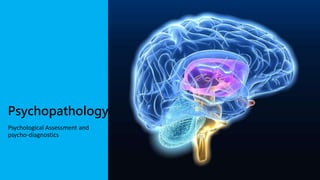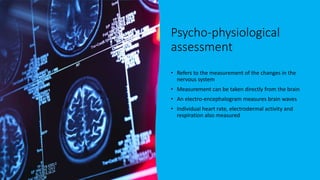Psychopathology.pptx
- 2. Clinical Assessments • Clinical Assessment is the evaluation and measurement of psychological, biological and social factors in individuals who present with possible disorders. • Clinical assessments entail gathering information and interpreting in a broader view • Diagnosis is the process of identifying the problem presented and which disorder fits the criteria
- 3. Basic steps in the diagnostic process • Ask the patient what is wrong • If more than once, rank problems from most important to least • Take full history and record relevant facts • Note observable signs, eg, fidgeting, eye contact • May need to do a neurological examination and etc
- 4. The clinical interview Allows the diagnostician to obtain: A detailed description of the presenting problem Accurate diagnosis of a variety of mental illnesses A detailed history of the patient’s life or his current situation including work, habits and relationship. Information about attitudes, emotions and past behaviour. Family history
- 5. Behaviour assessment • Process makes use of direct observation • Emphasis on determining unique details of the individual’s problem • Behaviour is predicted and controlled • Can take place at school, workplace or at home • Identify specific behaviour interfering with student’s learning • Leads to an intervention plan to improve the student’s learning
- 6. Causes of problem behaviour Attention seeking. Self-stimulation – Internal sensory positive reinforcement Escape from undesirable demands Medical conditions
- 9. Neuro-imaging • Accurate pictures of the brain structure and functioning • Studies the human brain in healthy and impaired populations. • Using a procedure called Computerised Tomography (CT) scan • And a Magnetic Resonance imaging (MRI) • Positron Emission Tomography (PET) This Photo by Unknown Author is licensed under CC BY
- 10. Psycho-physiological assessment • Refers to the measurement of the changes in the nervous system • Measurement can be taken directly from the brain • An electro-encephalogram measures brain waves • Individual heart rate, electrodermal activity and respiration also measured
- 12. Neurological assessment -Necessary for individual who has suffered head injury -Depression, dementia -Performing badly in school
- 13. Psychological testing Determine emotional, behavioural or cognitive responses that could be associated with specific disorder.
- 15. Types of tests • Personality inventories • Intelligence tests • Neuropsychological tests • Behavioural procedures • Aptitude tests • Achievement tests
- 16. False positives, false negatives, and malingering False positives, test results indicate a problem when there isn’t any. False negatives, test results indicate that there no problem when its present. Malingering, deliberately falsifying a test result
- 17. References • Paracha, S. (2014). Assessments in clinical settings. /sundasparacha3/assessments-in-clinical- settings?from_search=8 • Sanghvi, P. (2019). Behaviour analysis. /PrachiSanghvi3/behaviour-analysis- 199256939?from_search=7 • Bhaskar, P. (2017). Psychological testing. /preeti52/psychological-testing-82264985?from_search=0 • Dabhi, R. (2022). Clinical diagnosis seminar. /RutuDabhi/clinical-diagnosis-seminarpptx?from_search=0 This Photo by Unknown Author is licensed under CC BY-SA-NC
- 18. Continuation • Ragab, O. (2022). Advances in Neuro-imaging. /drosamaragab/advances-in- neuroimaging-140853246?from_search=3

















